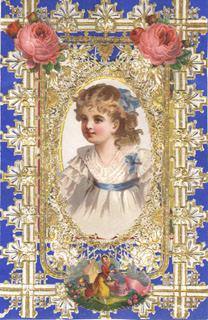VICTORIAN VALENTINE'S DAY HISTORY FACTS



| Some of the early Victorian
valentines were made of paper lace with romantic floral designs and scented
perfumes. The paper lace was made by treating the paper as if it were to
be lace work or embroidery work. The paper was often perforated, cutout
and embossed. These handmade valentines were very romantic. Lace paper is
said to have been created by Joseph Addenbrooke of London in 1834. The name
is often found embossed on the valentine. Some lace valentines had other
designs like pictures of angels, cupids, women and children. These reflected
the Victorian ideal of beauty flawless porcelain complexions, thick heads
of hair, rosebud lips and thick lashes.
The Victorians loved flowers so many valentines were manufactured with floral designs and pictures. The rose was especially suited to Valentines Day. Rosebud, tea roses and cabbage roses appeared alone and in bunchs on valentines of different sorts. Later in mid-Victorian England the
custom of these romantic valentines became passé. The Duke of London is rumored to
have made the first Valentine Day Card in 1415 while imprisoned in the
Tower of London. He wrote love poems or letter to his wife Francis. |
Cupid is known as the boy with the bow and arrow that pierces hearts. He is one of the best known valentine symbols of love. He is portrayed as a mischievous winged child armed with bow and arrow. The arrow signifies the desires and emotions of love. The arrow that Cupid aims at humans or Gods causes them to fall deeply in love.
In ancient Greece Cupid was known as Eros the young son of Aphrodite the goddess of love and beauty. To the Roman's he was cupid, and his mother was Venus. The story about Cupid and his mortal bride Psyche takes place in Roman mythology. Venus was jealous of Psyche's beauty and ordered her to be punished by Cupid. Cupid fell in love with her and took her as his wife instead. As a mortal she was forbidden to look at him.
One day Psyche decided to look at Cupid and he left her. Their lovely castle and gardens vanished too. She ended up alone in an open field with no sign of anyone. She wandered but did not find him. She came to the temple of Venus the goddess of love. This jealous woman gave her a series of tasks meant to break her spirt. She gave her a box and warned her not to open it. Of course she did and fell into a deadly slumber.
Cupid found her lifeless body on the ground. He gathered the deadly sleep from her body and put in back in the box. Cupid forgave her as did the Venus. The gods moved by her love for Cupid made Psyche a goddess. Today Cupid is one of the most popular signs of love especially assoicated with Valentine's Day.
The real history of St. Valentines Day is shrouded in mystery. The Catholic Church recognizes at least three saints whom were named Valentine or Valentinus. One legend is that Valentine was a priest that served druing the third century in Rome. Emperor Claudiso outlawed marriage because he believed single men made better soliders. Valentine realizing the injustice defied him and performed marriages ceremonies for young lovers in secret. Due to his actions he was put to death. Other stories suggest that Valentine helped Christians escape harsh Roman prisions where they were beaten and tortured. It is claimed he was killed on Febuary 14 270.

Commerical valentines were first made in the early 1800's. The format for these cards were blank inside, with space for the sender to write a message. Esther A. Howland became the first U.S. manufacturer of valentines. This was around 1847. Her business grew into a $100,000 a year enterprise. She began by making samples and took orders from stores. Later she hired a staff of women to set up and produce the cards in an assembly line format. One woman added lace, another paper flowers etc.
In England Valentines Day was celebrated in the 1400's. Many customs involved different ways single women could learn who their future husband would be. Some pinned five bay leaves to their pillows and were supposed to see their future husband in their dreams. In Derbyshire England young women circled the church 3 to 12 times at midnight and repeated verses. They believed the first man they see after this ritual they would marry within a year
In Demark people send pressed white flowers which are called snowdrops to friends. Danish men are known to send a joking letter. He signs a valentine with dots representing his name if the woman guesses his name then her rewards her with an Easter egg.
In the US and Canada children exchange valentines with their friends. Some schools hold classroom parties. Older students have dances and parties. The Ancient Romans held a festival on Febuary 15 to ensure protection from wolves. During this festival men struck women with strips of animal hide. It was believed this would increase their fertility.

Many valentine's in the 1800's were hand painted. Many cards had satin, lace, ribbon pasted or added to them. Some were even decorated with dried flowers, fake jewels and other items. British children sing special Valentine's Day songs and receive gifts of candy, fruit or money. In some areas of England people bake valentine buns with caraway seeds, plums or raisins. People in Italy hold a Valentine's Day feast
In Wales wooden spoons were carved and given as gifts on Feb. 14. Hearts, keys and keyholes were favorite decorations on the spoons. The decoration meant "You unlock my heart!"